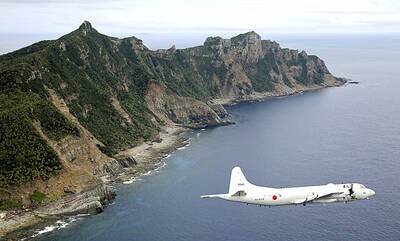Allowing Chinese law enforcement personnel to be stationed in Taiwan as part of cross-strait efforts to prevent crime is not a finalized plan, although that is what the two sides are working toward, a Crime Investigation Bureau (CIB) official said yesterday.
“So far, we don’t have a concrete plan, but we’re working in that direction,” CIB Crime Investigation Section Chief Chiu Nien-hsing (邱念興) was quoted as saying yesterday in a Central News Agency (CNA) report.
Chiu made the comments in response to a report published by the Chinese-language China Times Weekly magazine on Friday that Chinese law enforcement personnel may soon be allowed to be stationed in Taiwan.
The magazine said China had suggested that law enforcement personnel from both sides of the Strait — Taiwanese police officers and China’s People’s Armed Police — be stationed in each country to strengthen cross-strait cooperation on crime prevention.
The suggestion has already been submitted to President Ma Ying-jeou (馬英九) and to the Mainland Affairs Council (MAC) for review, and it may be discussed during cross-strait talks to be held at the end of the year, the report said.
The report also said Taiwan had requested that once a suspect wanted by Taiwan is arrested in China, Chinese law enforcement agencies should notify their Taiwanese counterparts within 24 hours.
When contacted by the Taipei Times for comment, CIB spokesman Liu Chung-chih (劉崇智) said it was a complicated issue and the CIB did not have such a plan at present.
“[Allowing Chinese law enforcement personnel to be stationed in Taiwan] is a very complicated issue because it would require laws to be revised and a lot of discussion,” Liu said. “We [the CIB] are only an executing agency, the decision-making power is in the hands of the MAC and other government authorities.”
“I can tell you that we don’t have such a plan at the moment,” he said.
When asked if it would be a future objective, Liu repeated that the CIB did not have such a plan at present.
Although the CIB denied there was any plan, the China Times Weekly report caused uproar on the Internet.
“Let’s wait and see — first it’s the police, next it will be the military,” an anonymous Internet user wrote on an online forum. “Once Chinese police and military can be legally present in Taiwan, it would be like telling the world we’ve been ‘liberated.’”
“Chinese police will soon be allowed to make arrests in Taiwan,” an Internet user with the screen name “cw” said. “Wuerkaixi, Professor Ruan Ming [阮銘], Tibetan dissidents and Taiwanese independence activists will be the first on the list.”
Both Wuerkaixi and Ruan are Chinese dissidents taking refuge in Taiwan.

MISINFORMATION: The generated content tends to adopt China’s official stance, such as ‘Taiwan is currently governed by the Chinese central government,’ the NSB said Five China-developed artificial intelligence (AI) language models exhibit cybersecurity risks and content biases, an inspection conducted by the National Security Bureau (NSB) showed. The five AI tools are: DeepSeek, Doubao (豆包), Yiyan (文心一言), Tongyi (通義千問) and Yuanbao (騰訊元寶), the bureau said, advising people to remain vigilant to protect personal data privacy and corporate business secrets. The NSB said it, in accordance with the National Intelligence Services Act (國家情報工作法), has reviewed international cybersecurity reports and intelligence, and coordinated with the Ministry of Justice Investigation Bureau and the National Police Agency’s Criminal Investigation Bureau to conduct an inspection of China-made AI language

LIMITS: While China increases military pressure on Taiwan and expands its use of cognitive warfare, it is unwilling to target tech supply chains, the report said US and Taiwan military officials have warned that the Chinese People’s Liberation Army (PLA) could implement a blockade within “a matter of hours” and need only “minimal conversion time” prior to an attack on Taiwan, a report released on Tuesday by the US Senate’s China Economic and Security Review Commission said. “While there is no indication that China is planning an imminent attack, the United States and its allies and partners can no longer assume that a Taiwan contingency is a distant possibility for which they would have ample time to prepare,” it said. The commission made the comments in its annual

‘TROUBLEMAKER’: Most countries believe that it is China — rather than Taiwan — that is undermining regional peace and stability with its coercive tactics, the president said China should restrain itself and refrain from being a troublemaker that sabotages peace and stability in the Indo-Pacific region, President William Lai (賴清德) said yesterday. Lai made the remarks after China Coast Guard vessels sailed into disputed waters off the Senkaku Islands — known as the Diaoyutai Islands (釣魚台) in Taiwan — following a remark Japanese Prime Minister Sanae Takaichi made regarding Taiwan. Takaichi during a parliamentary session on Nov. 7 said that a “Taiwan contingency” involving a Chinese naval blockade could qualify as a “survival-threatening situation” for Japan, and trigger Tokyo’s deployment of its military for defense. Asked about the escalating tensions

DISPUTE: A Chinese official prompted a formal protest from Tokyo by saying that ‘the dirty head that sticks itself out must be cut off,’ after Takaichi’s Taiwan remarks Four armed China Coast Guard vessels yesterday morning sailed through disputed waters controlled by Japan, amid a diplomatic spat following Japanese Prime Minister Sanae Takaichi’s comments on Taiwan. The four ships sailed around the Senkaku Islands — known as the Diaoyutai Islands (釣魚台) to Taiwan, and which Taiwan and China also claim — on Saturday before entering Japanese waters yesterday and left, the Japan Coast Guard said. The China Coast Guard said in a statement that it carried out a “rights enforcement patrol” through the waters and that it was a lawful operation. As of the end of last month,